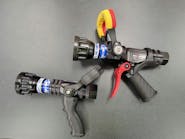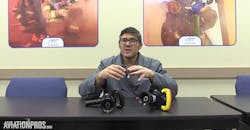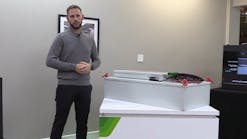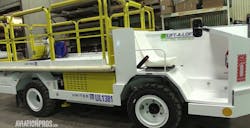Witnesses testifying Feb. 13 at a House aviation subcommittee hearing on
runway safety said that although the Federal Aviation Administration (FAA) has
made great strides in addressing the issue, runway incursions remain a major air
safety issue.
The most serious incursions, Categories A and B, actually declined from
69 incidents in Fiscal Year 1999 to 24 in FY2007, Department of Transportation
Inspector General Calvin Scovel said in testimony. But in the first three months
of this fiscal year, serious runways incursions have occurred at a rate that
could reach the highest level in six years.
The General Accountability Office (GAO), the congressional watchdog
investigative agency, noted that the number of serious incursions---where
collisions are narrowly or barely avoided---increased from two during the first
quarter of fiscal year 2007 to 10 during the same period of FY 2008, which began
on Oct. 1, 12007.
While saying the FAA has taken steps to address runway safety shortfalls,
"further progress has been impeded by the lack of leadership and coordination,
technological challenges, lack of data, and human factors-related issues," the
GAO added. It noted that the FAA's national runway safety plan hasn't been
updated since 2002, resulting in uncoordinated efforts within the agency. GAO
investigators echoed concerns of National Transportation Safety Board (NTSB)
members that air traffic controllers are fatigued and not working at top
performance.
Hank Krakowski, chief operating officer of the FAA's Air Traffic
Organization, told the House Subcommittee on Aviation that reducing the risk of
runway incursions is one of the FAA's top priorities, telling the lawmakers that
the number of serious runway incursions has dropped by more than 55 percent
since fiscal year 2001.
"Safety is our top priority, and runway safety starts with preventing
runway incursions," Krakowski said. "We remain focused to make the safest system
in the world even safer."
Krakowski discussed the FAA's major initiatives to track, investigate,
reduce and prevent runway incursions and errors. This past August, the FAA and
top-level industry executives agreed to an ambitious plan to improve cockpit
procedures, airport signage and markings, air traffic procedures, and
technology.
Runway Safety Action Teams visited 20 of the nation's busiest airports to
work on runway incursions, incidents of aircraft turning onto the wrong runway
and the risk of wrong-runway incidents. These teams identified more than 100
short-term fixes that could be accomplished within 60 days, including new or
improved signage, improved markings, driver training and other actions. The FAA
has now identified a second tier of 22 airports for evaluation.
Krakowski told the committee that the FAA has spent more than $404
million to date to acquire and deploy the next generation of ground surveillance
technology, known as Airport Surface Detection Equipment - Model X (ASDE-X) made
by Sensis. Eleven air traffic control towers now have ASDE-X installed, and the
agency has accelerated its installation schedule by one year. The target
completion date for the last system is now 2010. Thirty-five airports are slated
to get ASDE-X systems.
In addition, the agency is moving ahead with runway status lights, which
provide a direct alert to pilots about potential runway conflicts. The system is
currently being tested at Dallas/Ft. Worth International and at San Diego's
Lindbergh Field, and the FAA is selecting other large airports for testing.
The FAA is also testing a system at the Long Beach Airport, known as
Final Approach Runway Occupancy Signal (FAROS), which will further enhance
runway safety. The agency is developing a plan to implement FAROS at larger
airports and expects to begin operational trials at Dallas-Fort Worth by the end
of fiscal year 2008.
The FAA has been testing low-cost ground surveillance systems at Spokane,
WA, that would provide ground situational awareness to controllers at the
airports that are not slated to get ASDE-X systems. The FAA now plans to expand
this test to more sites later this year.
One system, the Nova 9000 Surface Management System, involves using X-
band radar to detect movement on the airport surface, and the other system, the
Critical Area Management System, would place millimeter wave sensors along
runways and taxiways to detect movement on the airport surface.
"To date, we have spent $4.5 million on this project and we are assessing
if it is an alternative safety measure for less busy airports not scheduled to
receive the ASDE-X system," said the head of the FAA's ATO.
In addition, the agency is working with the National Air Traffic
Controllers Association (NATCA) to implement a voluntary reporting system for
air traffic controllers similar to the Aviation Safety Program (ASAP) for
airlines, pilots, and airport workers. "I am convinced that information from a
voluntary reporting system will help us to spot trends and prevent future runway
incursions," the senior FAA official stated.
National Transportation Safety Board (NTSB) Vice Chairman Robert Sumwalt,
a former airline pilot, said that "incursions occur because both pilots and
controllers make mistakes...The reason is simple and compex----human error---and
there isn't any single solution that will eliminate the problem of runway
incursions."
Sumwalt said fatigue also causes mistakes. The Safety Board recommends
that the FAA set working hour limits for pilots, mechanics and controllers based
on fatigue research, circadian rhythms, and sleep/rest requirements. The FAA
should also develop fatigue awareness and countermeasures training programs for
controllers.
"The FAA has recently indicated its intention to convene a working group
to develop workable scheduling practices that minimize controller impairment due
to fatigue, and NATCA has indicated its willingness to support this effort,"
Sumwalt testified.
NATCA President Patrick Forrey said the controller's union was not
invited to participate in the aforementioned FAA working group.
NATCA recommends creation of a Runway Incursion Prevention Committee for
each airport since each one presents unique challenges that negate the
usefulness of universal solutions. These groups would be composed of the local
stakeholders, including pilots, air traffic controllers, airport management,
airport vehicle drivers, and the FAA.
Because runway incursions often occurs when the layout of taxiways force
aircraft to cross a runway in route to a second runway or gate, NATCA recommends
that End-Around Taxiways be constructed and utilized at all airports where such
construction is possible.
"The airlines remain unwavering in their commitment to safety and to
further improve an already stellar safety record," said ATA Vice President of
Operations and Safety Basil Barimo. "The airlines have identified several short-
term enhancements to further improve safety. However, the Next Generation
(NextGen) system, which still awaits congressional funding, holds the greatest
promise to provide a deeper level of pilot and controller situational
awareness."
Capt. John Prater, president of the Air Line Pilots Association, Int'l
(ALPA), said "the runway incursion risk is real and growing larger as our
National Airspace System is pushed to the max," said Prater. "The FAA
categorizes this risk as 'unacceptable'; we agree, but today I'm taking it a
step further. This rate of occurrence is inexcusable."
Prater said the runway incursion risk can be reduced by as much as 95
percent with the implementation of new technologies, training, and operational
techniques that increase pilots' and air traffic controllers' situational
awareness. Paired with simple solutions, such as improving runway and taxiway
markings with a can of paint, these mitigations can make a big impact.
ALPA also supports the construction of End-Around Taxiways as they
enhance both safety and capacity. Prater says perimeter taxiways drastically
reduce opportunities for runway incursions.
While U.S. airports are working to improve runway safety through a
variety of means, including investment in new technology, enhanced training and
improved surface markings, adequate funding from the FAA is necessary to develop
these programs fully and keep other key priorities on track, said John Duval,
airport safety and security coordinator, Beverly (Mass.) Municipal Airport, and
American Association of Airport Executives (AAAE) second vice chair.
"There is no easy fix and no magic bullet to improving runway safety and
reducing runway incursions. As in security, runway safety must be a multi-
layered approach with numerous checks and balance. Although we don't have all
the answers yet, we are making progress on improving runway safety through a
variety of means, including the use of new technology, enhanced taxiway
markings, airfield changes and improved training," he told the lawmakers.
Several large airports, including Atlanta Hartsfield-Jackson, Boston
Logan, Dallas/Fort Worth, and San Diego, have implemented new or redesigned
taxiways designed to create safer and more efficient airfields, Duval testified.
Atlanta has built an End-Around Taxiway that eliminates hundreds of runway
crossings per day, reduces delays and boosts departure capacity. Dallas/Fort
Worth, which reports having about 1,700 runway crossings per day, is nearing
completion on a perimeter taxiway project in its airfield's southeast quadrant
and has plans to install similar taxiways in the other three quadrants over the
next decade.
Duval also underscored the important role that training plays in an
airport's runway safety program. AAAE provides a set of tools and educational
opportunities designed to help airports meet their safety goals.
Duval noted that airports quickly embraced new enhanced centerline and
holding-position marking standards established by FAA in 2005. According to FAA
figures, 71 of 75 airports have put the new markings in place, and the other
four will have done so well in advance of the agency's June 30, 2008, deadline.
FAA recently proposed expanding the markings standards to cover the other
500 certificated Part 139 airports. Duval noted that, even though the proposed
advisory circular is still not finalized, some 180 airports expect to have
adopted the new markings by the end of the year, bringing both enhanced safety
and standardization to a significant percentage of the nation's commercial
airports.
"While this may seem like a relatively inexpensive way to improve runway
safety, simply painting these markings can cost nearly $500,000 at a large hub
airport," Duval said. "Requiring all Part 139 airports to enhance their surface
markings will place additional funding requirements on smaller airports with
limited Airport Improvement Program [AIP] funds and Passenger Facility Charge
[PFC] revenue."




